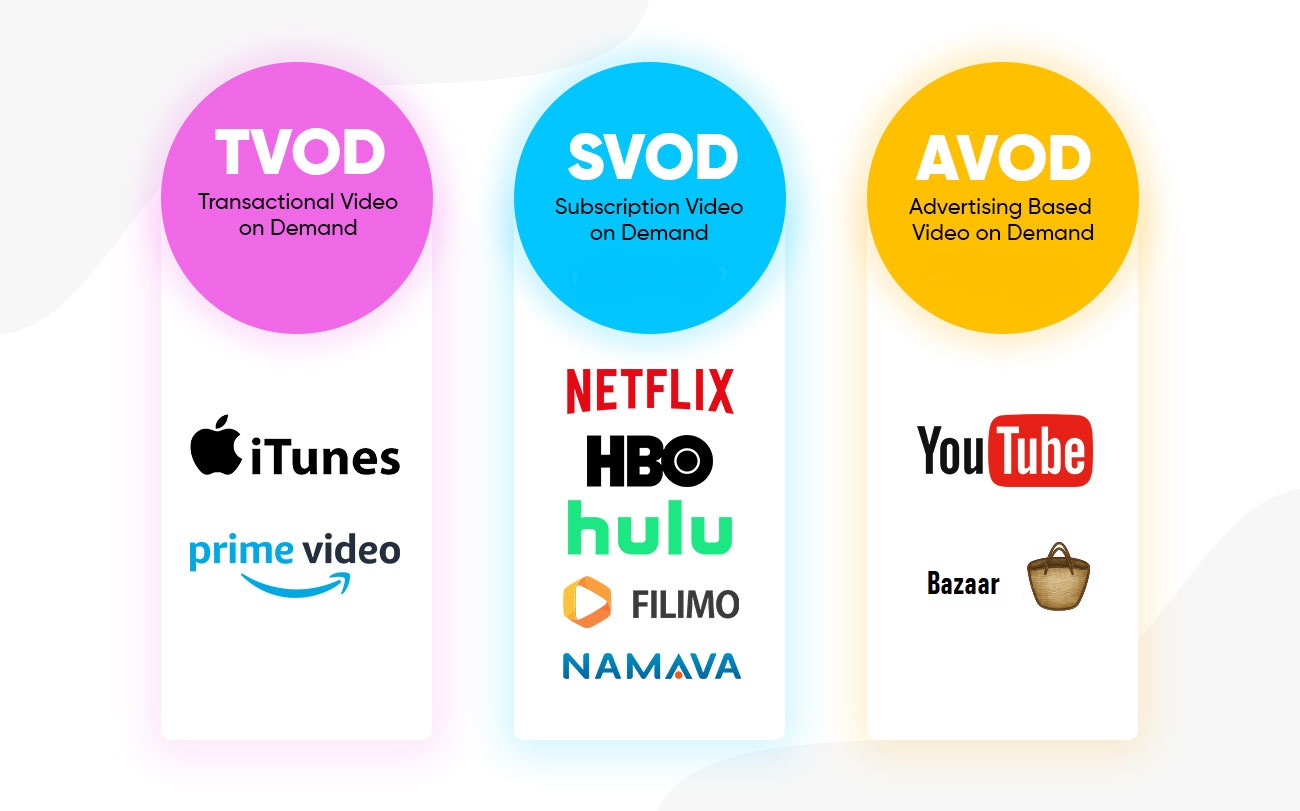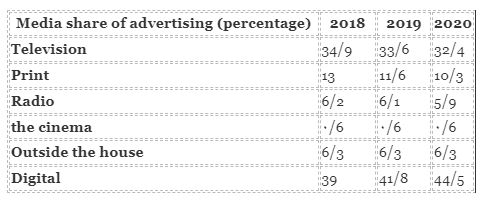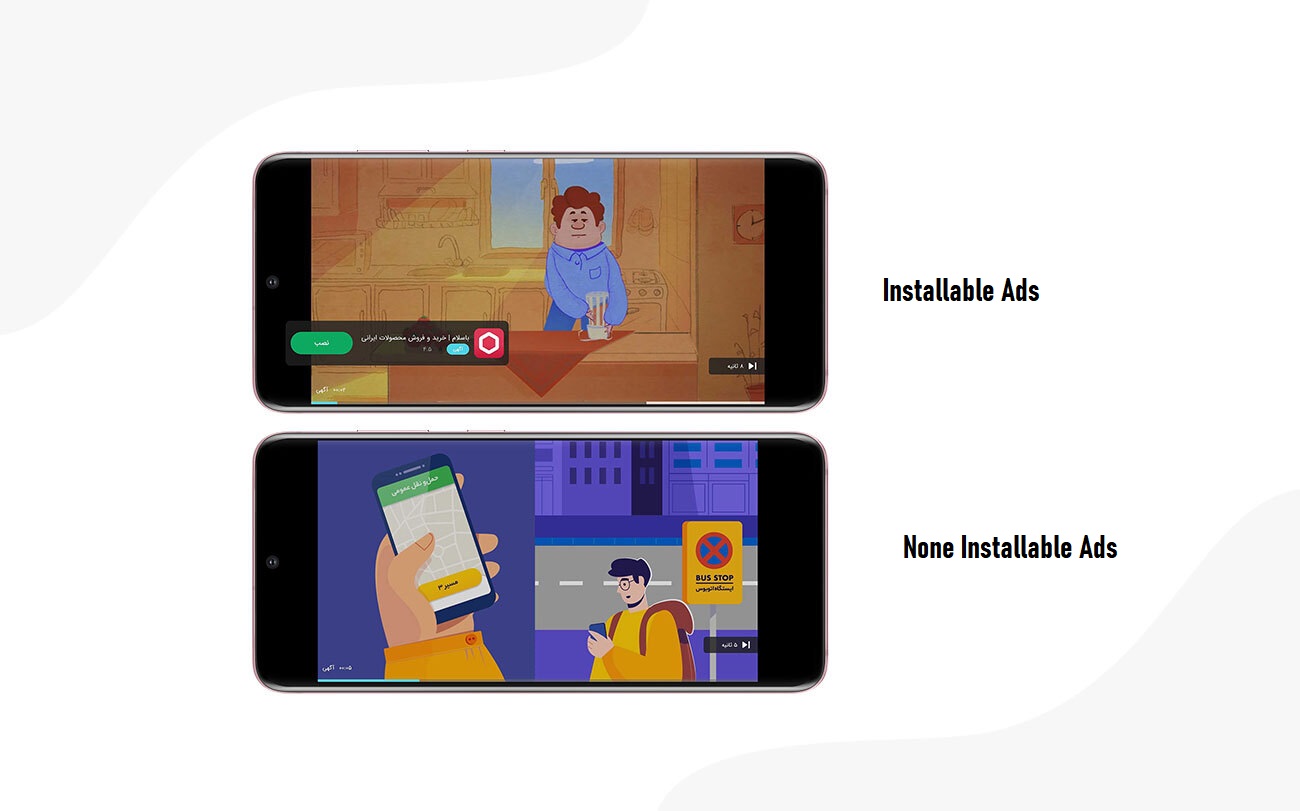What Is Interactive Media Or VOD And What Services Does It Provide For Businesses?
Interactive Media Or VOD Has Become Very Popular In Recent Years and Provides Good Opportunities For Business Advertising. Bazaar Cafe Is Also One Of The Main Players In This Field, Which We Will Describe In The Following VOD Service.
It is impossible to imagine a user in today’s world of technology who has not heard the names of services such as Netflix, Hulu, and Amazon Prime. Interactive video-on-demand or VOD (Video on Demand) services have become very popular recently and are even gradually replacing traditional TVs.
The popularity of this type of service increased so much that it also encouraged big players such as Disney and Warner Bros. and the Apple brothers to work in the new field.
In our country, in recent years, several VOD services have been born to attract domestic audiences. Today, most Iranian users are familiar with Filimo and Nemava and new personal services such as the video market section, and many use their services.
Recent months, accompanied by the Coronavirus crisis and widespread shutdowns worldwide and in our country, have increased the desire for this type of service. Many of them have experienced a significant increase in the number of users.
The influx of new users to the services was so great that some of them even faced infrastructure challenges, and others were forced to reduce the quality of their content on a large scale to manage bandwidth better.
Interactive media or VOD and providing services and content to the user or end-user have also created a new channel for businesses to display ads. While services such as Namava and Filimo follow the Subscription Video on Demand (SVOD) monetization model, services such as YouTube and Bazaar follow the AVOD or Ad-based Video on Demand model, which is gaining traction among businesses and interactive media services these days. Reviews and commentary on various VOD services and how we take advantage of the existing infrastructure for businesses.

What is VOD, and when did it flourish?
VOD is simply a video media distribution system that allows the user to access video content in a process, unlike traditional TVs. In VOD, there is no need for traditional TV equipment, and the user will not be limited to the schedule of the content distribution network. The naming of “video at the time of request” also derives from this initial definition.
In other words, the VOD user will have access to any video content in the service library from any of their smart devices (TV, phone, laptop, and tablet ) at any time.
Televisions were the most important channel for distributing video content in the twentieth century with the structure we know. In 1995, with the introduction of Internet and IPTV services, users began to adopt new ways of consuming video content.
This new direction of demand led to the development and supply of VOD services and even increased the purchase of personal computers.
With the advent of the 21st century and the improvement of Internet infrastructure, it became possible to develop VOD.
As we enter the 21st century, the development of infrastructure for VOD service delivery has accelerated. Unlike traditional TV, these services required a high-speed Internet connection instead of a cable or antenna.
In 2000, a codec called JPEG2000 was developed that made it possible to distribute video content with less volume and lower bandwidth and speed requirements.
By 2000, giants such as Sony, Paramount, Universal, and Warner Bros., along with several other reputable companies, developed the Digital Cinema Initiative standard to implement common specifications for Internet video streaming.
Internet TV was a concept born of VOD services. User-friendly apps like Apple iTunes Online Content Store and smart TV apps like Amazon PrimeVideos resulted from this concept, which allowed the user to rent or purchase video content and display it on various devices.
Other services were born in the meantime that provided the user with access to a collection of entertaining video content and movies and series.
Among them are the streaming industry giant Netflix and competitors such as Hulu and Disney Plus, who have opted for shared service and a monthly subscription fee to serve users.
For a monthly fee, these services offer the user access to all the content in their library, including TV, movie, and series programs and their own production programs. Similar internal examples of these services include Filimo and Namava.

Youtube also falls into the category of VOD services and has an ad-based business model. Of course, this platform also offers a shared service called YouTube Premium to the user, which also provides an ad-free experience in all its various sections, including YouTube, YouTube Music, and YouTube Gaming.
In other words, the YouTube user must either view the ads on the platform or pay for not displaying the ads and accessing specific content. YouTube recently introduced a model of TVOD where users can buy and watch movies and animations, which is a small part of YouTube’s business.
Other examples of VOD include services provided by some airlines to their passengers, which allow them to enjoy the desired video content through their internal displays.
Types of VOD services
Interactive media services are divided into different groups depending on the type of service they provide to users or generate revenue. The three main groups of VOD are SVOD, AVOD, and TVOD, each of which is described below.
SVOD or Subscription Video on Demand
SVOD services are very similar to traditional TVs. The user can view the content in the service library indefinitely by paying monthly fees (or any desired period of time).
These interactive media services have faced a sharp increase in users in the last decade, especially in the last few years. In the following sections, we will introduce the best examples of them.
Users have more freedom when using SVOD. They do not need a long-term contract with the service provider and can leave if they are unsatisfied with the content or service.
This freedom of action poses a difficult customer retention challenge for SVOD operators. They generally try to attract and retain audiences by providing proprietary content and fierce competition for licenses to broadcast popular movies and series.

Top streaming or SVOD services
As mentioned, streaming services are one of the most popular VOD subsets in the world. The user will have access to a huge collection of video content just by subscribing and does not need to pay a separate fee to watch the video. In addition, some provide users with free access to some of their proprietary content, which attracts more consumers.
Among the top current services of the streaming industry, the following can be mentioned:
- Netflix: Huge collection of attractive video content with optimized user interface and convenient video suggestion system. Weaknesses include relatively high costs than others ($ 99.8 per month) and occasional additions and deletions of programs.
- HBO Now and HBO Go: HBO’s popular and reputable network streaming service with proprietary professional content, engaging movies, and exclusive news programs. Of course, it costs much more than competitors ($ 99.14 per month), and some programs are removed from the service.
- DisneyPlus: Affordable media giant streaming service ($ 7 a month) full of engaging and popular content with UHD quality content options. Its weaknesses include quality problems and user interface disorders.
In the following rankings of the best streaming services, the following options can be mentioned:
- Hulu
- Amazon Prime Video
- Sling TV
- Fubo TV
- Crackle
Among similar domestic services, Namawa and Filimo are the most popular. Of course, Internet operators have also launched their own services to provide content with free traffic to their customers. Other Iranian services include:
- Aio
- Epidote
- Filmnet
- plan
- lens
- Tiwa
- Isima
- Watch
- sofa
- Digiton
- Mobile appearance
- Cinema Market

TVOD or Transactional Video on Demand
Interactive trading media, or TVOD, stands in stark contrast to SVOD. The user of these services buys or executes the content according to the number of views. One of the sub-categories of this category is EST or Electronic sell-through, in which the user pays a one-time fee for content to be received and accessed permanently.
Another subset is DTR or Download to rent, making video content available to the user for a limited time for a fee.
Many users prefer watching ads to paying for video content
International TVOD services generally provide more up-to-date content to the user and improve content producers’ revenue. They generally try to attract and retain audiences through pricing competitions. Popular services in this category include Apple iTunes, Skybox, Amazon Video Store, and PlayStation Video.
AVOD or Advertising-based Video on Demand
These interactive media do not charge the end-user. Their advertising approach is very similar to that of traditional television. The user does not pay to watch the original video content but will be required to watch the ads.
Ads that display the service and advertiser configuration at the beginning or middle of the main content. One of the most popular services in this category is YouTube internationally and Aparat and Bazaar in Iran.
Of course, there is a big difference between the content of the video market and the camera. While users produce the bulk of the apparatus content, the video market segment comprises premium video content (such as Filimo and Namavar content), including various movies, animations, and serials.
Some companies in the VOD industry use the above models to generate revenue and provide services to users. As mentioned, despite being active in the AVOD category, YouTube allows users to purchase subscriptions and not show ads while accessing proprietary content. Another example is Amazon Video, which charges separate subscribers for certain sporting events or new movies.
Opportunity for business advertising using VOD services
Over the years, the advertising sector in the digital space has increased significantly. At present, digital platforms, surpassing television, introduce themselves as the main platform available for business advertising.

In the previous sections, we realized that the biggest advantage of interactive media services, or VODs, is the freedom of access to video content for the user. In fact, users are no longer limited to a predetermined schedule of TV networks and will be able to access any video content at any place and time through all their smart devices. As a result, personalized experiences are created from the user’s desired content.
The online advertising industry is mostly focused on user behavior.
In fact, the main advantage of this industry is in providing appropriate advertisements to each user.
VOD services have access to huge amounts of data about user behavior in content consumption. As a result, advertisers can use users’ behavioral information to offer ads relevant to each person’s interests in VOD systems.
Simply put, ads for a particular product on VOD are only displayed to the user interested in that product or related category.
The nature of interactive media makes it possible for business advertisements to be exposed to more potential customers than traditional television. In other words, your product will be indefinitely exposed to the audience instead of being shown for a limited time.
| Media share of advertising costs | 2018 | 2019 | 2020 (forecast) |
|---|---|---|---|
| Banner | 75/474 | 82/090 | 90/221 |
| Online video | 35/721 | 43/142 | 50/749 |
| Social Networks | 17/860 | 21/571 | 25/688 |
| Search engine | 86/997 | 94/673 | 102/751 |
| Categorized ads | 18/436 | 19/774 | 20/675 |
AVOD services have gradually found their place among users over the past few years.
After SVODs became the main choice for video-interested users for a long time, ad-centric services came to the attention of advertisers for access to more users.
Although the vast majority of users turn to SVOD services to see no ads, some SVOD players have begun to display ads in their content over time, which, according to surveys, has received a lot of negative feedback from consumers around the world. Had.
Recent AdWeek research shows that SVOD companies’ decision to shrink the content library and focus more on proprietary content has created a significant market vacuum.
Users who have been looking for infinite content on VOD services will soon be faced with a limited set of dedicated series and movies.
Gradually, they prefer to watch ads as a cost to access a larger collection of content on AVOD.
Keep in mind that AVOD services generally have more content and often use the broadcast licensing method for existing content.
Recent changes and the growing market demand for AVOD services make it possible for streaming or SVOD companies to become interested in this business model gradually.
Netflix, for example, cites advertising reliance in its financial statements as a way to monetize the cost of producing proprietary content and may gradually increase its reliance on that model.
Finally, it seems that AVOD services are becoming a growing and popular part of the VOD business. New services are likely to integrate this business model over time, and existing services may interest them.
As a business owner or digital marketing manager, do not forget that the main advantage of these services is better access to a potential audience.
The number of video viewers in Iran has increased significantly in recent years.
With a growth of 23% compared to 2017, this statistic has now reached 52 million users from 28, which shows the large platform of activities and advertisements in this field.
With a share of 86% versus a 14% share of desktops, Mobile is the main device for Iranian users to operate and display in the digital field.
Online streaming video ads
Video ads displayed on VOD systems fall into various categories. Every business considers a specific type of advertising, depending on the target audience and the results they expect from their advertising. In the following, we will get acquainted with different types of video ads.
The most popular category of online video ads is displayed when the original video is playing. These ads are displayed before, during, or after the main video, depending on the design and purpose. All in-stream ads are displayed on the same player as the original video.

Linear video ads
These in-stream ads take up the entire space of media content distribution. The use of the term linear is because they are consistently displayed in the timeline of the original video. Linear ads are divided into Pre-roll, Mid-roll, and Post-roll categories depending on the airtime.
The duration of linear ads is generally considered to be between 15 and 30 seconds. Businesses also make it impossible to get ahead of their time to implement linear ads optimally.
Regarding aspect ratio, 4: 3 and 16: 9 are common, with 16: 9 having more fans.
- Show pre-roll ads: As the name implies, VOD platforms broadcast them before the main video. The pre-roll category has many advantages because it somehow requires the user to watch the ad. Of course, there are negative points in the mentioned ads, and in some cases, the user will be able to reject the ad.
- Display ads in the middle of the main video (mid-roll): This video ad category is displayed in the middle. The main video stops in the background and resumes after watching the ad. The important thing about using middle-of-the-road ads is to schedule them in the middle of the main video to make it look as similar to the original content as possible. Intermediate ads are seen above all categories because the user rarely leaves the main video to see them.
- After the main video (post-roll), show ads: This category of video ads receives the lowest traffic because they do not want to watch them. However, with some solutions such as CTA, their engagement rate can also be increased.
Nonlinear video ads
These ads are displayed at the same time as the main content. Clicking on the ads will stop the original video. After clicking, a complete video can be displayed to the user throughout the player or redirected to another destination, such as a website or social network.
Nonlinear video ads are categorized into two groups.
To get the most out of this type of ad, it is recommended to shorten the video time to five to 10 seconds and add the ability to close the ad:
- Overlay Ads: Overlay ads appear as layers on the main content. These ads typically take up 20% of the broadcast space at the bottom of the page to minimize user distraction. These ads can be used to permanently display the product or announcements while playing the original video. Of course, their weakness is seen in the coverage of important information such as descriptions and subtitles.
- Non-Overlay Ads: These ads are seen inside the main broadcaster but do not cover the main video. In fact, ads are displayed separately and can include a call to action (CTA). Of course, the content of non-cover ads can also be somewhat distracting to users.
In which category does the video market segment fall?
Bazaar Cafe recently launched its own video service, which now uses the AVOD model in the video market segment. Most video content on the market is free, and users will see ads instead of paying to watch content, such as the YouTube monetization model.
Currently available on the market application of performance ads (installation) and non-performance ads (brand awareness).
The difference between the market and YouTube and Aparat
As described, the market also uses the AVOD model to display video content. The main difference between the video market segment and platforms like YouTube is in the type of content.
In Aparat and YouTube, content is produced by users, and for this reason, the quality of all content cannot be considered at a high level. In the film, serial, and animation market, however, almost all of the content in the video segment makes up for them, which can be categorized as premium, high-quality content.
Ads will only be shown on content such as new and popular series that users have not produced.
Types of ads in the market
There are currently two models of advertising on the video market.
- Performance ads (application installation)
- Non-performance advertising (brand awareness)

Performance ads (application installation)
In this advertising model, and thanks to the nature of the AppStore market, the application is installed without taking the user out of the video watching environment. After the user starts playing the video, a video ad is played, and at the same time, the installation key (call to action) is placed at the bottom of the video.
Clicking the install button will display a message to download the application after closing the player. After the user leaves the video, the application is installed in the background.
If the user does not want to watch the ad, after 10 seconds, the “Reject” button will appear. Touching it will allow you to delete the ad and display the desired video content.
In performance ads, the user is not sent to a new page or landing. The process of downloading and installing the application takes place without any disruption to the video viewing experience.
Non-performance advertising (brand awareness)
These ads are similar to the examples being broadcast on radio and create awareness among the audience. Like other platforms, the marketer provides the advertiser with extensive statistics and information such as the number of views, the number of keystrokes pressed, the number of times the video is closed, and the number of times the ad is viewed.
These ads do not have a call to action button; But like radio commercials, non-performance cultures such as SMS to specific numbers or phone calls can be embedded.
The closest external example of non-performance brand awareness advertising is Hulu, which uses big brands for advertising and raising their business awareness while watching movies and TV series.

Market advertising
According to market managers, targeting based on the adult and adolescent genres is currently available in the video advertising section of the market. In the coming months, targeting based on age and gender will be added.
In installation advertisements, various crackers such as Matrix, Agile, Adetris, and Adjust are supported, and the installation fee is calculated based on the installation registered by the cracker.
Comprehensive reports, including the number of views, closing the page, the number of times the ad was rejected by the user, the amount of time the ad was viewed to measure the quality of video ads, will also be provided to the advertiser.













